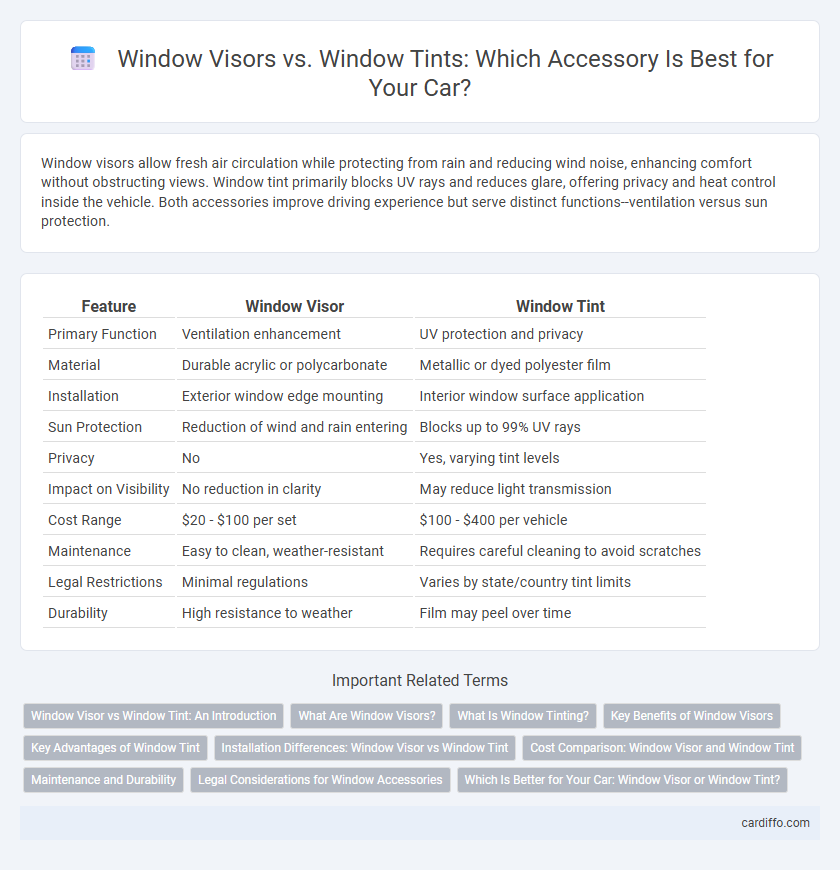Window visors allow fresh air circulation while protecting from rain and reducing wind noise, enhancing comfort without obstructing views. Window tint primarily blocks UV rays and reduces glare, offering privacy and heat control inside the vehicle. Both accessories improve driving experience but serve distinct functions--ventilation versus sun protection.
Table of Comparison
| Feature | Window Visor | Window Tint |
|---|---|---|
| Primary Function | Ventilation enhancement | UV protection and privacy |
| Material | Durable acrylic or polycarbonate | Metallic or dyed polyester film |
| Installation | Exterior window edge mounting | Interior window surface application |
| Sun Protection | Reduction of wind and rain entering | Blocks up to 99% UV rays |
| Privacy | No | Yes, varying tint levels |
| Impact on Visibility | No reduction in clarity | May reduce light transmission |
| Cost Range | $20 - $100 per set | $100 - $400 per vehicle |
| Maintenance | Easy to clean, weather-resistant | Requires careful cleaning to avoid scratches |
| Legal Restrictions | Minimal regulations | Varies by state/country tint limits |
| Durability | High resistance to weather | Film may peel over time |
Window Visor vs Window Tint: An Introduction
Window visors and window tints serve distinct purposes as automotive accessories, with window visors primarily designed to deflect rain and reduce wind noise while allowing fresh air flow, whereas window tints enhance privacy, reduce glare, and block harmful UV rays. Window visors are typically made of durable acrylic or polycarbonate material and are installed above the vehicle's windows to create a channel for ventilation without letting rain enter. Conversely, window tints involve applying a thin film to the glass surface, which varies in darkness and UV protection levels, directly influencing heat reduction and interior fading prevention.
What Are Window Visors?
Window visors are aerodynamic accessories installed above the car windows to allow fresh air circulation while protecting the interior from rain and reducing wind noise. Made from durable, tinted acrylic or polycarbonate, they enhance driving comfort by enabling windows to stay slightly open in various weather conditions. Commonly used to improve ventilation, window visors also contribute to a sleek vehicle appearance and help prevent fogging inside the car.
What Is Window Tinting?
Window tinting involves applying a thin, transparent film made of polyester or similar materials to vehicle windows, designed to reduce heat, glare, and UV radiation while enhancing privacy. This accessory improves driving comfort by blocking up to 99% of harmful ultraviolet rays, preventing interior fading and cracking. Compared to window visors, window tinting provides continuous sun protection and a sleek aesthetic without altering the window's ability to open or close.
Key Benefits of Window Visors
Window visors improve ventilation by allowing fresh air circulation while protecting the interior from rain and wind, enhancing driving comfort in various weather conditions. They reduce wind noise and sun glare, contributing to a quieter and safer driving experience. Unlike window tint, visors do not obstruct visibility or require legal restrictions, making them a practical and versatile accessory for vehicle windows.
Key Advantages of Window Tint
Window tint enhances privacy by limiting visibility from outside while maintaining clear interior views, effectively reducing glare and UV radiation. It significantly lowers interior temperatures, improving comfort and protecting upholstery from sun damage. Unlike window visors that only deflect rain and wind, window tint offers increased energy efficiency and bolsters vehicle security through strengthened glass resistance.
Installation Differences: Window Visor vs Window Tint
Window visors are installed externally using adhesive strips or clips, allowing for easy removal and repositioning without affecting the interior of the vehicle. Window tints require precise application of specialized film directly onto the interior glass, demanding professional tools and skills for bubble-free adhesion and proper curing. The installation of window visors is typically quicker and less invasive compared to the meticulous and time-consuming process required for window tinting.
Cost Comparison: Window Visor and Window Tint
Window visors typically cost between $20 and $100 per set, offering a budget-friendly option for weather protection and ventilation. Window tint prices vary widely from $100 to $400 or more, depending on film quality, coverage area, and professional installation. Choosing between the two depends on budget constraints and desired functionalities, with visors being more affordable and tint providing UV protection and privacy benefits.
Maintenance and Durability
Window visors are typically made from ABS plastic, offering high resistance to weather conditions and requiring minimal maintenance such as occasional cleaning with mild soap and water. Window tint films, often made from polyester, need careful upkeep to avoid bubbling or peeling, generally involving gentle cleaning with specialized solutions and avoiding abrasive materials. In terms of durability, visors can last several years without fading or cracking, while high-quality tints may maintain effectiveness for up to a decade if properly maintained.
Legal Considerations for Window Accessories
Window visors and window tints are subject to specific legal regulations that vary by state, focusing on allowable tint darkness, reflection levels, and visor installation methods. Compliance with Department of Transportation (DOT) standards ensures both accessories do not impair driver visibility or vehicle safety features. Failing to adhere to these legal limits can result in fines, vehicle inspection failures, or the mandatory removal of non-compliant window accessories.
Which Is Better for Your Car: Window Visor or Window Tint?
Window visors provide ventilation by allowing fresh air to flow while reducing wind noise and preventing rain from entering, making them ideal for drivers who prioritize comfort during adverse weather. Window tints enhance privacy and reduce heat and UV exposure, protecting the interior from sun damage and increasing energy efficiency. Choosing between window visors and window tint depends on whether you value improved airflow and weather protection or UV defense and privacy for your vehicle.
Window Visor vs Window Tint Infographic

 cardiffo.com
cardiffo.com